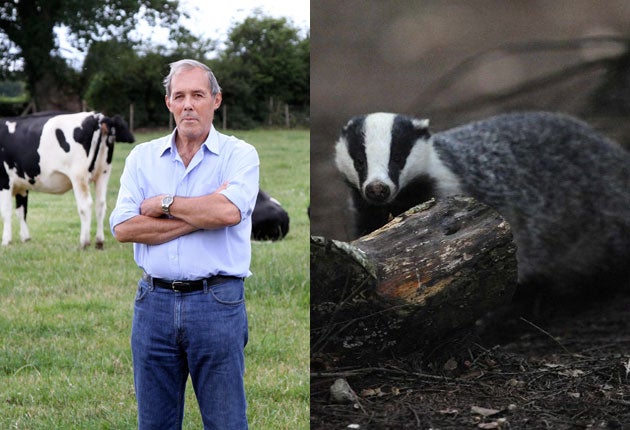Beneath the rolling Gloucestershire hills they scurry, their noses wet as they feast on the abundance of slugs and earthworms that the temperate English countryside provides.
But there is trouble in badger paradise, with the Environment Secretary "strongly minded" to approve a cull on the much-loved creatures on the grounds that they spread bovine tuberculosis through cattle populations.
In the impending war on badgers, Gloucestershire is Ground Zero. Almost a third of cattle herds in the county are infected, meaning costly restrictions on their sale and movement. But as scientists debate the effectiveness of a cull, which would be carried out after tests next summer and which would be met with opposition from animal rights activists, many farmers are desperate to get started.
Jan Rowe, 66, who keeps 180 dairy cows and as many beef cows on his 550 acres at Whalley Farm in Whittington, near Cheltenham, has had one year free of TB in his herds since 2000. He is advancing plans for marksmen to work their way through the area killing the badgers. In the Seventies he says he had three badger sets. Now there are five or six, and several sub-populations.
Mr Rowe said: "The disease is spreading to the north and the east, it is spreading to llama, deer, sheep, pigs, even domestic cats. It is nigh on out of control. There should have been a cull 15 or 20 years ago. More badgers will die now than would have then. It is not the badgers we are trying to fight, it's TB."
TB spreads aerobically from animal to animal, much like the common cold. As badgers live in stuffy underground setts in such close proximity, it spreads quickly among them. Where more than one badger population exists within range of another, they mark out territory by building latrines, effectively fortifications of excrement around their setts. If the population is carrying tuberculosis, these latrines, which sit where cows graze, are rife with the disease.
The badger became protected under the 1973 Protection of Badgers Act, which sought to stop badger baiting. Since then there has been little farmers can do to control populations.
The proposed cull leaves the problem of perturbation. Surviving badgers from a largely culled set have shown a propensity to go wandering around the countryside, dazed and confused, spreading the disease yet further.
The new cull proposes farmers join in syndicates which cover areas of several hundred square kilometres, with clear boundaries, such as rivers, coasts or motorways. Marksmen will shoot the nocturnal creatures by night.
But they will not do so without a fight. Adam Henson, of BBC's Countryfile, received mail from animal rights activists last month threatening to "burn his children" merely for reporting on the cull proposals.
Mr Rowe said: "If you have to live with this disease you realise you will have to put up with [activists'] nonsense to get something done. We might get a few nutters trying to sabotage, but it will be very hard for them to find out, over such a wide area, when or where the culling is going on."
Mr Rowe estimates the cull would have to go on for a minimum of four years, or until such a point as vaccines are ready. The aim is to kill 70 per cent of the badger population, estimated in England as between 288,000 and half a million.
Subscribe to Independent Premium to bookmark this article
Want to bookmark your favourite articles and stories to read or reference later? Start your Independent Premium subscription today.


Join our commenting forum
Join thought-provoking conversations, follow other Independent readers and see their replies